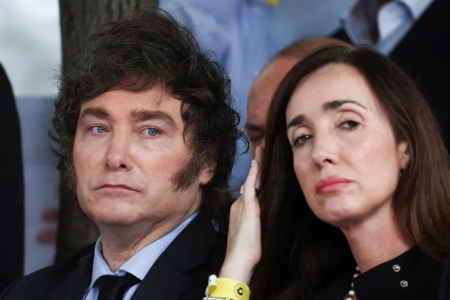All the Answers
Well-known member
Milei's 100 days and the end of a bitter honeymoon: between a painful adjustment and the hope of a way out - Infobae

Source:

Los 100 días de Milei y el final de una luna de miel amarga: entre un ajuste doloroso y la esperanza de una salida
Hoy concluyó el período que todos los gobiernos tienen para poner en marcha la gestión. El líder libertario ejecutó un ajuste ortodoxo que no tiene antecedentes históricos y que cree traerá una rápida recuperación. La política ya lo frenó dos veces. ¿Hasta cuándo aguanta la clase media?
March 19, 2024
Today concluded the period that all governments have to implement the management. The libertarian leader executed an orthodox adjustment that has no historical precedent and that he believes will bring a rapid recovery. Politics has already stopped him twice. How long can the middle class last?
By Facundo Chaves

Javier Milei completed the first 100 days of his government today
The first 100 days of government are often called the “honeymoon . ” All presidents have that period to implement their plans, programs and ideas, while the people who voted for them and, above all, those who did not vote for them, support and empathize with the new tenants of power. These are days in which all governments usually apply the most difficult measures and in which they “spend” the bulk of their political capital. And Javier Milei is no exception, although as in everything, he has his own formula.
In these three and a half months, the libertarian president launched an ultra-orthodox adjustment plan that does not recognize antecedents in history: he devalued, stopped issuance, deregulated large sectors of the economy, shrank the structure of the State, reduced direct and indirect subsidies . And he signed a decree of necessity and urgency and a bill with extensive political and social reforms, which ended up being rejected by the Senate and Deputies, respectively. As an economist and specialist in growth with and without money, Milei began to change the economy, but found an inevitable and predictable limit in politics. The libertarian leader arrived, among others, with two main mandates: lower inflation and end insecurity.
These are phenomena that occurred while the majority of surveys - from Aresco, to Poliarquía, from Opina Argentina to Insonomía, among others - confirm that the first libertarian president retains popular support of between 45% and 55%. According to these surveys, Milei seems to be in tune with the people, but he is unable to translate that popular support into essential regulatory advances to provide institutional solidity to the reforms required by an Argentina that was bound for 20 years by regulations, controls, and traps. and protections.
It is part of what libertarians call “the cultural battle,” which has economic aspects, but is mainly an ideological dispute. It is the repudiation of public spending, gender ideologies, social policy managed by piqueteros and Kirchnerist leaders, and cultural expressions that hide partisan interests.

Milei and Vice President Victoria Villarruel
From the fleeting oath before the Legislative Assembly and the speech with his back to Congress, Milei did not give up in his attack against “the caste” and collected from each Chamber the consistent response to that challenge. Led by Kirchnerism, which remains united and achieves momentary accessions from radicals and governors of provincial parties, the opposition blocs showed the President his firepower. When the “Omnibus Law” was discussed, there were 160 votes against in the Deputies out of a total of 270, while in the Senate the rejection of the DNU had 42 votes against and only 25 in favor.
Both results occurred before and after Milei's speech to the assembly that met on March 1 for the opening ceremony of ordinary sessions. There he proposed to the political class an iron dilemma: agreement or conflict. The same governors and legislators who heard him decided to vote against him. They did not avoid a head-on collision because they have been accumulating annoyances and unsatisfied political needs since the new government began.
A report published in January by Infobae anticipated for the first time the vertical drop that transfers to the provinces had had. “Stepping on the box” was the tool that the President used to weaken the “party of governors” that emerges every time there is no Peronist in the Casa Rosada. Milei cut transfers as much as possible - and a little more - with the aim of grinding down governors who claim political independence despite having an undeniable economic dependence on the National Treasury.
The apparent double defeat in Congress, however, clearly exposed the new ideological quadrants, or the members of the renewed rift. Now, on the one hand, there are Milei and his libertarians, plus the PRO - soon chaired by Mauricio Macri -, a sector of radicalism and the tactical and unstable allies of the provinces. And in front, Kirchnerism, the most progressive radicals, the left and the provincial governors who depend on national funds. Regarding these groups, Milei and Macri lead, while Cristina Kirchner intends to recover a centrality that she lost due to her responsibility in the last government chaired by Alberto Fernández.
While these discussions are still alive in the “red circle”, President Javier Milei trusts that the recipes in the manuals that trained him as an economist will work and, thus, he can advance in the two measures that he believes will give Argentina a unusual takeoff: the opening of the stocks and the free choice of currency, which is “the clothes with which” the well-known dollarization is dressed. These are the stimuli that the libertarian leader offers to get through the bad times of April and May. Hence, in public and in private, the president asks for patience and trust. In the face of painful adjustment, hope.

